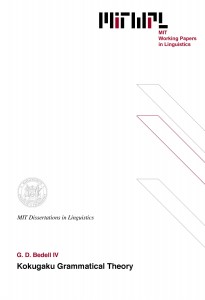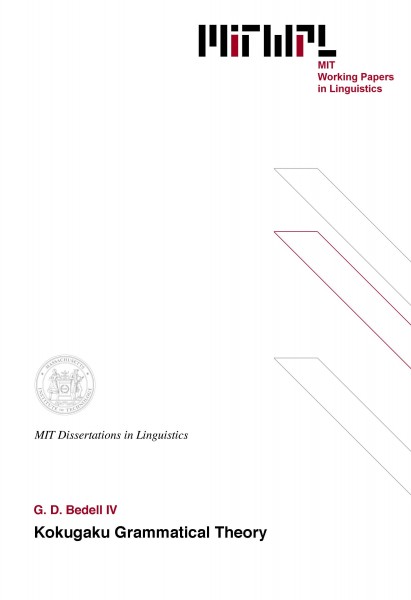Kokugaku Grammatical Theory
G. D. Bedell IV, 1968
The primary objectives of this thesis are to describe the linguistic theory which is inherent in kokugaku grammar, and to assess the impact of this theory on the subsequent development of grammar in Japan. What is to be discussed is 1) the content of the theory, comparable in most respects to that of European traditional grammatical theory; 2) the contact and cross-fertilization of kokugaku grammar and European traditional grammar; and 3) the conflict between kokugaku grammar and the tenets of some forms of modern linguistics.
Referred to under 1) above are works of Fujitani Seishō, Motoori Noringa, Suzuki Akira, Motoori Haruniwa, Gimon and Togashi Hirokage; under 2), works of Yamada Yoshio; and under 3), works of Tokeida Motoki. Important appendices include a historical background sketch, and a translation of Suzuki Akira’s Gengyo Shishu Ron.
Thesis supervisor: Noam Chomsky
Title: Professor of Modern Languages and Linguistics
Table of Contents
Chapter I: Introduction. . . . . . . . . . . . . . . . . . . . . . 1
A. Form and Objectives. . . . . . . . . . . . . . . . . . . 1
B. Generative Grammar. . . . . . . . . . . . . . . . . . 7
C. Traditional Grammar. . . . . . . . . . . . . . . . . . 11
Footnotes to Chapter I. . . . . . . . . . . . . . . . . . . . . 17
Chapter II: The Content of Kokugaku Grammatical Theory. . . . . . . . 24
A. External Considerations. . . . . . . . . . . . . . . . . 24
1. Some Questions. . . . . . . . . . . . . . . . . 24
2. Limitations. . . . . . . . . . . . . . . . . . . 27
3. Theoretical Unity. . . . . . . . . . . . . . . . . 31
4. Origins (1): India and Europe. . . . . . . . . . . 34
5. Origins (2): China. . . . . . . . . . . . . . . . 37
6. Conclusion. . . . . . . . . . . . . . . . . . . 41
B. The Description of Japanese. . . . . . . . . . . . . . . . 42
1. The Divisions of Kokugaku Grammar. . . . . . . . . 42
2. Kokugaku Syntax. . . . . . . . . . . . . . . . . 46
a. The Noun-modifier Relation. . . . . . . . . . 46
b. The Subject-predicate Relation. . . . . . . . . 56
c. The Structure of Verb Phrases. . . . . . . . . 66
d. Passives and Causatives, Transitives and
Intransitives. . . . . . . . . . . . . . . . 76
3. Accidence in Kokugaku Grammar. . . . . . . . . . 82
4. The Parts of Speech in Kokugaku Grammar. . . . . . . 91
C. Kokugaku Grammar and Universal Grammar. . . . . . . . . 100
1. Chinese and Japanese. . . . . . . . . . . . . . . 100
2. Literary and Colloquial Japanese. . . . . . . . . . . 106
3. Kokugaku Grammar and the Theory of Grammar. . . . . 108
Footnotes to chapter II. . . . . . . . . . . . . . . . . . . . . 116
(A.) . . . . . . . . . . . . . . . . . . . . . . . . . 116
(B.) . . . . . . . . . . . . . . . . . . . . . . . . . 120
(C.) . . . . . . . . . . . . . . . . . . . . . . . . . 136
Chapter III: Kokugaku Grammar and European Traditional Grammar. . . . 142
A. Yamada Yoshio’s Place in Japanese Grammar. . . . . . . . . 142
B. Yamada’s View of Sentence Structure. . . . . . . . . . . . 147
C. Yamada’s Version of the Parts of Speech. . . . . . . . . . . 151
D. Yamada’s Evaluation of Kokugaku Grammar. . . . . . . . . 157
E. Yamada’s Grammatical Theory in Relation to Kokugaku
Grammatical Theory. . . . . . . . . . . . . . . . . . . 161
Footnotes to chapter III. . . . . . . . . . . . . . . . . . . . . 165
Chapter IV: Kokugaku Grammar and Structural Linguistics. . . . . . . . 176
A. Tokieda Motoki’s Place in Japanese Grammar. . . . . . . . 176
B. Tokieda’s Critique of the Cours de Linguistique Générale . . . 181
C. Tokeida’s Notion of Shi and Ji. . . . . . . . . . . . . . . 184
D. Tokeida’s Evaluation of Kokugaku Grammar. . . . . . . . . 188
E. Tokeida’s Grammatical Theory in Relation to Kokugaku
Grammatical Theory. . . . . . . . . . . . . . . . . . . 191
Footnotes to chapter IV. . . . . . . . . . . . . . . . . . . . . 195
Appendix A: Conventions. . . . . . . . . . . . . . . . . . . . . . 203
Appendix B: Historico-bibliographical Introduction to Kokugaku Grammar. . 205
Appendix C: Gengyo Shishu Ron (translated) . . . . . . . . . . . . . . 227
Appendix D: Partially Annotated List of References. . . . . . . . . . . . 268

